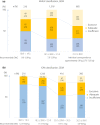Association between pre-pregnancy body mass index and gestational weight gain and perinatal outcomes in pregnant women diagnosed with gestational diabetes mellitus: The Japan Environment and Children's Study
- PMID: 34845867
- PMCID: PMC9077720
- DOI: 10.1111/jdi.13723
Association between pre-pregnancy body mass index and gestational weight gain and perinatal outcomes in pregnant women diagnosed with gestational diabetes mellitus: The Japan Environment and Children's Study
Abstract
Aims/introduction: We investigated the association between gestational diabetes mellitus (GDM) and perinatal outcomes stratified by pre-pregnancy body mass index (BMI) and/or gestational weight gain (GWG).
Materials and methods: Data from the national birth cohort in the Japan Environment and Children's Study from 2011 to 2014 (n = 85,228) were used. Japan uses the GDM guidelines of the International Association of Diabetes and Pregnancy Study Groups. The odds ratios (ORs) of perinatal outcomes were compared between women with and those without GDM.
Results: The OR (95% confidence interval) of having a small for gestational age infant in the GDM group with a pre-pregnancy BMI of ≥25.0 kg/m2 and insufficient GWG (<2.75 kg) was 1.78 (1.02-3.12). The OR of having a large for gestational age infant of the same BMI group with excessive GWG (>7.25 kg) was 2.04 (1.56-2.67). The OR of hypertensive disorders of pregnancy was higher in women with a BMI ≥18.5 kg/m2 in the GDM group than in the non-GDM group.
Conclusions: Large for gestational age and hypertensive disorders of pregnancy were associated with pre-pregnancy BMI and GWG in either normal weight or overweight/obese women, and the relationship was strengthened when GDM was present. Women with GDM and a BMI of ≥25.0 kg/m2 are at risk of having small for gestational age and large for gestational age infants depending on GWG.
Keywords: Body mass index; Gestational diabetes mellitus; Gestational weight gain.
© 2021 The Authors. Journal of Diabetes Investigation published by Asian Association for the Study of Diabetes (AASD) and John Wiley & Sons Australia, Ltd.
Figures


Similar articles
-
Weight gain after diagnosis of gestational diabetes mellitus and its association with adverse pregnancy outcomes: a cohort study.BMC Pregnancy Childbirth. 2021 Mar 17;21(1):216. doi: 10.1186/s12884-021-03690-z. BMC Pregnancy Childbirth. 2021. PMID: 33731035 Free PMC article.
-
Gestational diabetes mellitus, pre-pregnancy body mass index and gestational weight gain predicts fetal growth and neonatal outcomes.Clin Nutr ESPEN. 2021 Apr;42:307-312. doi: 10.1016/j.clnesp.2021.01.016. Epub 2021 Feb 12. Clin Nutr ESPEN. 2021. PMID: 33745597
-
Joint and Independent Associations of Gestational Weight Gain and Pre-Pregnancy Body Mass Index with Outcomes of Pregnancy in Chinese Women: A Retrospective Cohort Study.PLoS One. 2015 Aug 27;10(8):e0136850. doi: 10.1371/journal.pone.0136850. eCollection 2015. PLoS One. 2015. PMID: 26313941 Free PMC article.
-
Practical weight management to minimize pregnancy complications and promote women's health: the possibility of interpregnancy care.Nagoya J Med Sci. 2024 May;86(2):160-168. doi: 10.18999/nagjms.86.2.160. Nagoya J Med Sci. 2024. PMID: 38962410 Free PMC article. Review.
-
Gestational Diabetes: Overview with Emphasis on Medical Management.Int J Environ Res Public Health. 2020 Dec 21;17(24):9573. doi: 10.3390/ijerph17249573. Int J Environ Res Public Health. 2020. PMID: 33371325 Free PMC article. Review.
Cited by
-
Non-efficacy of early intervention strategy for non-obese patients with early-onset gestational diabetes mellitus: solely based on the short-term outcomes.BMJ Open Diabetes Res Care. 2023 Jun;11(3):e003230. doi: 10.1136/bmjdrc-2022-003230. BMJ Open Diabetes Res Care. 2023. PMID: 37270179 Free PMC article.
-
Association of Maternal Diet with Infant Birthweight in Women with Gestational Diabetes Mellitus.Nutrients. 2023 Oct 26;15(21):4545. doi: 10.3390/nu15214545. Nutrients. 2023. PMID: 37960200 Free PMC article.
-
Pre-pregnancy body mass index and glycated-hemoglobin with the risk of metabolic diseases in gestational diabetes: a prospective cohort study.Front Endocrinol (Lausanne). 2023 Sep 28;14:1238873. doi: 10.3389/fendo.2023.1238873. eCollection 2023. Front Endocrinol (Lausanne). 2023. PMID: 37842297 Free PMC article.
-
Association between eating habits during adolescence and gestational diabetes: data from the Japan environment and children's study.J Diabetes Metab Disord. 2023 Sep 24;22(2):1625-1633. doi: 10.1007/s40200-023-01294-2. eCollection 2023 Dec. J Diabetes Metab Disord. 2023. PMID: 37975095 Free PMC article.
-
The exploration of optimal gestational weight gain after oral glucose tolerance test for Chinese women with gestational diabetes mellitus.Sci Rep. 2024 Jan 17;14(1):1466. doi: 10.1038/s41598-024-51879-x. Sci Rep. 2024. PMID: 38233459 Free PMC article.
References
-
- Rasmussen K, Yaktine AL. Weight Gain During Pregnancy: Reexamining The Guidelines. Washington, DC: National Academies Press, 2009. - PubMed
-
- Damm P, Houshmand‐Oeregaard A, Kelstrup L, et al. Gestational diabetes mellitus and long‐term consequences for mother and offspring: a view from Denmark. Diabetologia 2016; 59: 1396–1399. - PubMed
-
- Japanese Ministry of Health, Labour and Welfare National nutrition survey in Japan. 2011.
MeSH terms
Grants and funding
LinkOut - more resources
Full Text Sources
Medical

